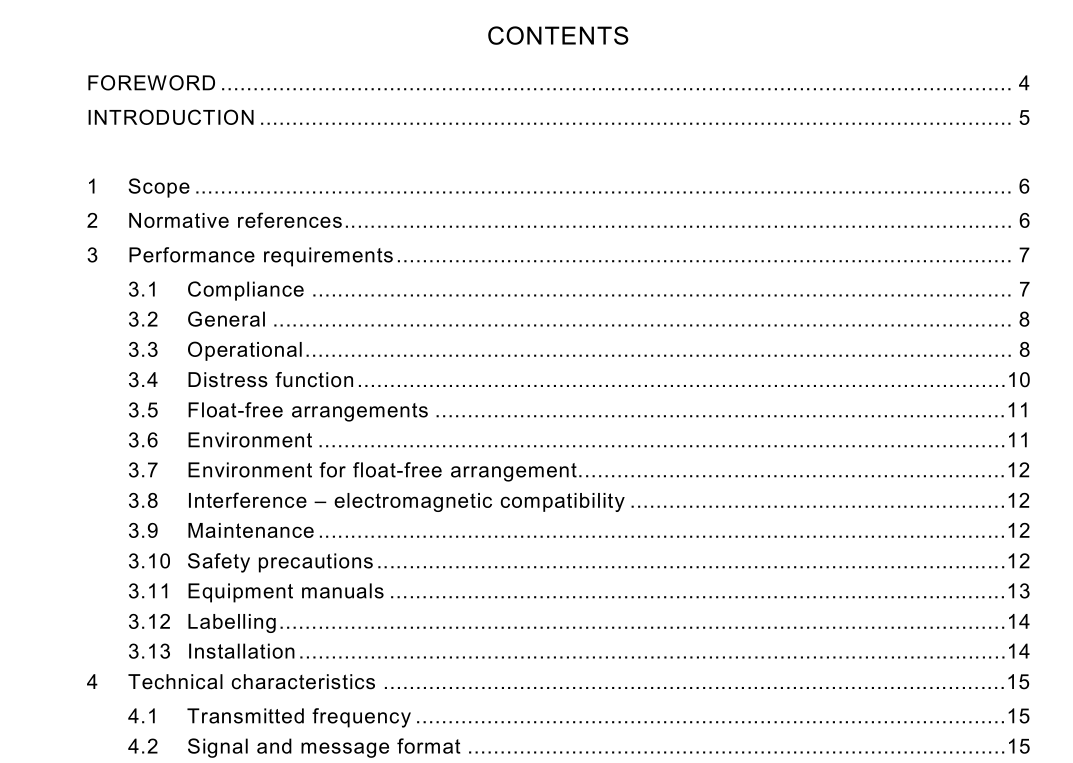IEC 61097-2 pdf download

IEC 61097-2 pdf download.Global maritime distress and safety system (GMDSS)
1 Scope
This part of IEC 61097 specifies the minimum performance requirements, technical charac- teristics and type-testing requirements of the satellite emergency position-indicating radio beacon used in the COSPAS-SARSAT satellite system (satellite EPIRB), as required by Regulation IV/7.1.6 of the 1988 amendments to the 1974 International Convention for Safety of Life at Sea (SOLAS), and which is associated with IEC 60945 (General requirements). When a requirement in this standard is different from IEC 60945, the requirement in this standard shall take precedence. This standard also includes minimum performance standards for a manually activated satellite EPIRB without float-free release mechanism (see annex C). This standard incorporates the performance standards of IMO Resolutions A.810(19) Performance Standards for float-free satellite emergency position-indicating radio beacons (EPIRBs) operating on 406 MHz and A.662(16) Performance Standards for float-free release and activation arrangements for emergency radio equipment, the International Telecommunication Union (ITU) Radio Regulations as well as the technical characteristics for such transmitters contained in Recommendation ITU-R M.633 (as amended), and takes account of the general requirements contained in IMO Resolution A.694(17). All texts of this standard, whose wording is identical to that in the IMO SOLAS Convention 1974 as amended in 1988 and Resolutions A.658(16), A.662(16), A.689(17), A.694(17), A.696(17), A.702(17) and A.810(19)and Recommendation ITU-R M.633 will be printed in italics and the Resolution/Recommendation and paragraph number indicated between brackets.NOTE 1 Classes of satellite EPIRB’s considered in this document are: – Class 1: Float-free (–40 °C to +55 °C). The float-free release mechanism (A.662(16)) should be capable of operating throughout the temperature range of –40 °C to +65 °C. This class is not required by IMO Resolutions but may be applied at the discretion of each Administration. – Class 2: Float-free (–20 °C to +55 °C). The float-free release mechanism (A.662(16)) should be capable of operating throughout the temperature range of –30 °C to +65 °C. NOTE 2 Non-float-free, manually activated satellite EPIRB’s in both classes are considered in annex C. NOTE 3 All classes shall include a 121,5 MHz homing device, described in annex D. User experience of COSPAS-SARSAT EPIRB operation leading to some clarification of IMO performance standards, and providing some useful information for satellite EPIRB users is included in annex E.
3 Performance requirements
3.1 Compliance (A.810(19)/A.1) The satellite emergency position-indicating radio beacon (EPIRB) shall, in addition to meeting the requirements of the Radio Regulations, the relevant ITU-R Recommendations and the general requirements set out in resolution A.694(17) comply with the following performance Standard. In addition to this performance Standard, the satellite EPIRB shall comply with the requirements of COSPAS-SARSAT documents C/S T.001 and C/S T.007, as amended. The radio frequency of operation of the equipment shall at all times be within the limits defined by the Radio Regulations.3.2 General a) The satellite EPIRB shall be (IV/7.1.6.3) ready to be manually released and capable to be carried by one person into a survival craft. b) (A.810(19)/A.2.1) The satellite EPIRB shall be capable of transmitting a distress alert to a polar orbiting satellite service operating in the 406 MHz band. c) It shall be designed to operate according to this standard when floating in the sea and shall also be capable of operating on board a ship and on a survival craft. d) (A.810(19)/A.2.2) The satellite EPIRB shall be of an automatic float-free type. The equipment, mounting and releasing arrangements shall be reliable and operate satisfactorily under the most extreme conditions likely to be met with at sea. e) (A.662(16)/1) Float-free release and activation arrangements shall enable the automatic release of the satellite EPIRB from a sinking ship and its automatic activation. Table 1 shows the correct combination of control functions to prevent or enable activation.









